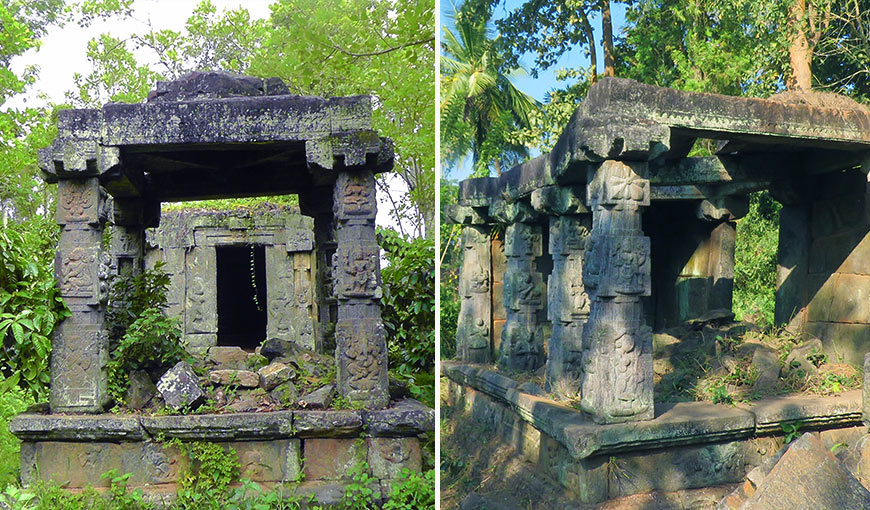Jain Temples at Panamaram

Panamaram Jain temple is a damaged ancient religious center of Jains in Wayanad. Ruins of other similar small constructions are also found around this ruined temple. According to the ancient history of Wayanad Jains is the first group who migrated to Wayanad. The Kannada speaking people in Wayanad are known as Jains, they belong to the Digambara sect and they are called Gowadas. Hoysala kings were the rulers of Kamataka’in the 12th century and Wayanad was a part of Karnataka. At that time Wayanad was known as Bailnad. The rulers of Hoysala Dynasty were Jains till Vishnuvardha. Around the medieval period, Saiva religion became a stronghold in Karnataka and the frequent attacks from Salva religion to Jain lead to the migration of Jains to Kerala and especially to Wayanad.
The migrated Jains first came to Panamaram on the banks of Kabini river. From there the Jain groups spread to the different parts of Wayanad. These Jains were basical1y farmers. Digging and plowing were against their belief. So as to keep their belief they introduced eco-farming in Wayanad. Jainism was at its peak in Wayanad during the days of Hoysala Dynasty. Hoysala kings promoted Jainism and they sent many missionaries to the different parts to spread Jainism. There are many proofs, which justify the existence of Jainism in Wayanad. The history tells us that the Bathery Jain temple was built 800 years ago. Earlier this temple was known as Kidangad Basti and the older name of Bathery was Hennaredu Bedhi (twelve streets). These two names are Kannada names and it shows the influence of the Kamataka Jains. Some other similar place names are Bennagode (Venniyode), Palagonthu (Palukunnu), Muthangadi (Puthangadi), and Hosengadi (Mananthavady).
The Jain temple constructed by means of stones appears to be rectangular in shape with numerous spectacular carvings on its walls and pillars. These temple ruins are the fine examples of great architecture and excellent stone sculpturing tradition prevalent in ancient times. The carvings on the temple walls as well as pillars represent Vaishnava iconography which is remarkable in all respects.
The entrance of the temple is seen in the middle of one of the walls of the construction. The doorway is made extremely marvelous with exclusive carvings which enable viewers to think about the sculpturing dreams and skills of people lived during the primitive era. The doorway then leads to an elevated position or stage supported by sculptured stone pillars having fantastic carvings. The innermost sector of the construction is appeared to be Sanctum Sanatorium of the holy shrine where the main rituals would have been carried out. Neither idols nor images of Thirthankaras are seen inside the Sanctum Sanatorium of the temple. It could have been moved to some other temple or museums. Unfortunately, the temple is seemed to have fallen during some years ago and locals would have tried to keep these fallen stones at their respective position aiming restoration.
The layout and architectural style of the Panamaram Jain Temple shows its great influence and importance during its functional days. The partly ruined temple with an area rather derelict, generate an atmosphere of mystery about the heritage site. Currently, this Jain temple is partly concealed by a coffee estate in the region.
It is believed that the Jainism was strongly rooted among the inhabitants of Wayanad during the early era. The remains of constructions related to Jainism indicate the strong influence of the religion in the area.
It is believed that the wall inscriptions in Edakkal Caves are closely related to Jainism. The Swastik mark, the mark of the seventh Tirthankara, Suparswa Natha, has been engraved on the wall. The Chandrabimbamark, the mark of the eighth Tirthankara, Chandra Natha, also can be seen on the wall of the cave. The other inscriptions on the wall are the Hoysala kings’. The former Hoysalas were Jains. In the 13th century, Jainism was at its peak in Wayanad. By the end of 18th century the religion became too weak because of the increasing influence of the Hindu religion and the invasion of Saiva – Vaishnava religions. The relics of many ruined temples can be seen in Bathery, Puthangadi, and Poothadi.
recent posts
- Chembra Peak-Ideal Place for Trekking in Wayanad
- Spice Plantation in Wayanad
- Myth Behind Chain Tree in Wayanad
- Phantom Rock
- Kabini River
- Jain Temples at Panamaram
- Wayanad Waterfalls
- Edakkal Caves
- Kanthanpara Waterfall
- Banasura Sagar Dam
- Soochipara Waterfalls / Sentinel Rock Waterfalls
- Neelimala Viewpoint
- Sulthan Bathery
- Pakshipathalam
- Brahmagiri Trek
- Wayanad Wildlife Sanctuary
- Pazhassi Raja and Wayanad
- Monsoon in Wayanad
- Lakkidi View Point

